Update! As a result of this review, Eartheasy, the North American distributor of the Lifestraw, sent me a few products to try out, and I appreciate when a company is willing to stand behind its products like that. I still feel that the Lifestraw itself is less useful than its fans make it out to be, and that the bottled version is the only version hikers and travelers should consider purchasing. I’ve given specific comments on the bottled version down below, which is worth a look as a portable filter for hiking and other outdoor activities.
As many of you may know, clean drinking water is kind of a big deal. The fact that nowadays we can get drinkable water, right at home, practically for free, is a downright revolutionary (and thoroughly recent) development, and one which remains entirely out of reach for billions throughout the world.
Enter the Lifestraw: A small, lightweight, portable, durable, relatively inexpensive filtration device that can hang around your neck like a necklace, providing you with filtered water wherever you go. It has won an endless string of accolades, and has even been called “one of the ten things that will change the way we live,” with legions of adoring fans singing its praises, swearing by its use in situations of all sorts.
Unfortunately, I think it’s bizarrely overrated.
What’s the Lifestraw?
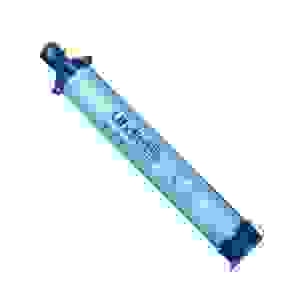
The Lifestraw is a hollow-membrane filter built into a straw. You place the straw into the water, and drink. Sucking the water up through the straw forces it through the filter, which removes 99.9999% of bacteria, and 99.9% of protozoa, down to 0.2 microns, with a filter that lasts for 1000 liters, for about $20. Not bad, right?
That’s pretty good, but on the downside, it won’t remove microscopic minerals, chemicals, or viruses.
This isn’t necessarily a deal-breaker, since most water will be fine, especially if you’re just filtering river water to avoid getting sick…but this thing was designed for the third world, with viruses all over the place, meaning you’d need iodine or other methods to eliminate the potential threat of viral diseases.
It’s certainly better than nothing, and preventing most water-borne diseases is better than preventing none. The Lifestraw was designed to provide excellent filtration at a reasonable cost, which is probably more effective than providing perfect filtration at a high cost, which could very well be too expensive to accomplish its own goals of third world disease reduction. Again, missing the viruses isn’t a deal-breaker, and it can prevent a huge number of water-borne diseases from infecting at-risk populations, but people talk about this thing like it’s the messiah of water filters.
But that’s not even the most annoying part.
The weird problem no Lifestraw review ever seems to mention
I have gone over this problem again and again in my head, looking at the endless cavalcade of glowing Lifestraw reviews, “Invention of the Century” accolades, and legions of ardent fans, and cannot fathom why no one seems to notice or care.
Take a look at the snazzy in-action shot of a guy using the Lifestraw out in the real world:

What happens when you walk away from the water?
No more water.
So if you’re heading into riverless mountains, or the desert, or a 12 hour bus ride in body-temperature heat, or any other situation in which you won’t have access to water, you’ll have to fill up a water bottle ahead of time, and whenever you want a drink of water, you have to:
- Open the bottle
- Open the Lifestraw’s top cap
- Open the Lifestraw’s bottom cap
- Stick the Lifestraw inside
- Drink
- Take it out
- Expel the remaining water
- Close the top cap
- Close the bottom cap
- Close the bottle.
And then…you’ve got a wet Lifestraw, so you’ll probably end up with wet clothes. Sexy!
People talk about how “simple” this is, as if handling three caps instead of one is somehow…simple?
On a related note, imagine traveling with this thing, and trying to fill up from a sink. You’d have to plug the sink, fill it up, wait for it to get deep enough to drink, then take a few sips, unplug the sink, and walk away. Imagine being incredibly thirsty and trying to do this in a hurry. Now imagine you’re about to get on a 12 hour bus ride through midday temperature highs, and all you had ahead of time was a quick sip from the sink, and that’s all you’ll have until the next time you get to another sink, when you’d begin the sink plug process anew. Just for one sip.
Seriously, has anyone actually used this thing?
What the Lifestraw should have been
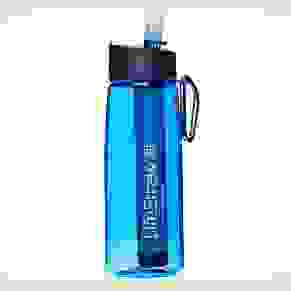
So here we finally are, at a product that’s actually recommendable. The Lifestraw Go. They took the Lifestraw and stuck it inside a water bottle, which eliminates the pointless inconvenience of only being able to drink with water nearby, or having to deal with three different caps and two separate objects for every sip.
But damn…the Lifestraw has been around since about 2005, and this bottled version only started shipping around 2013. This means that for 8 long years, nobody ever bothered asking “Dude, what if you walk away from the river but you’re still thirsty?” Sigh.
This bottled version was designed for the consumer market, which makes a lot of sense, and it’s true that shipping a million regular Lifestraws to disaster zones or poverty-stricken rural areas is logistically easier than shipping a million bottled Lifestraws, as they’d need maybe 5 or 6 times as many shipments due to the size, but damn…how does anyone use the regular one more than a few times without going crazy?
While it’s true that the original Lifestraw was designed for simplicity, portability, durability, and ease of use (and somewhat succeeds), I just can’t see many good reasons not to stick it inside a water bottle in the first place. Particularly from a consumer standpoint, the bottled version is clearly the correct answer here.
Update: I can think of ONE situation in which the straw by itself might be more useful than a bottle: Trail running, near a river. You can strap it to your leg, so it doesn’t bounce around, and you’re always near an outdoor water source, which would only need this type of filtration, and wouldn’t need a bottle.
But, ranting aside, is it a good filter? Is it a cost-effective solution to commonplace water purification needs, third world or otherwise? Could this be the one and only water purification method you employ, whether hiking in the mountains, or adventuring throughout the developing world?
Well…maybe.
Remember, it still can’t filter viruses, which is what you’d want in developing countries.
That’s not to say it’s not useful. A $35 water bottle that provides 0.2 micron filtration which lasts for 1000 liters certainly isn’t bad.
But on the other hand, you can just get the Sawyer Water Bottle, which manages 0.1 micron filtration for a guaranteed 3.7 million liters for a one-time cost of $50.
Um…tell me again, why is the Lifestraw so popular?
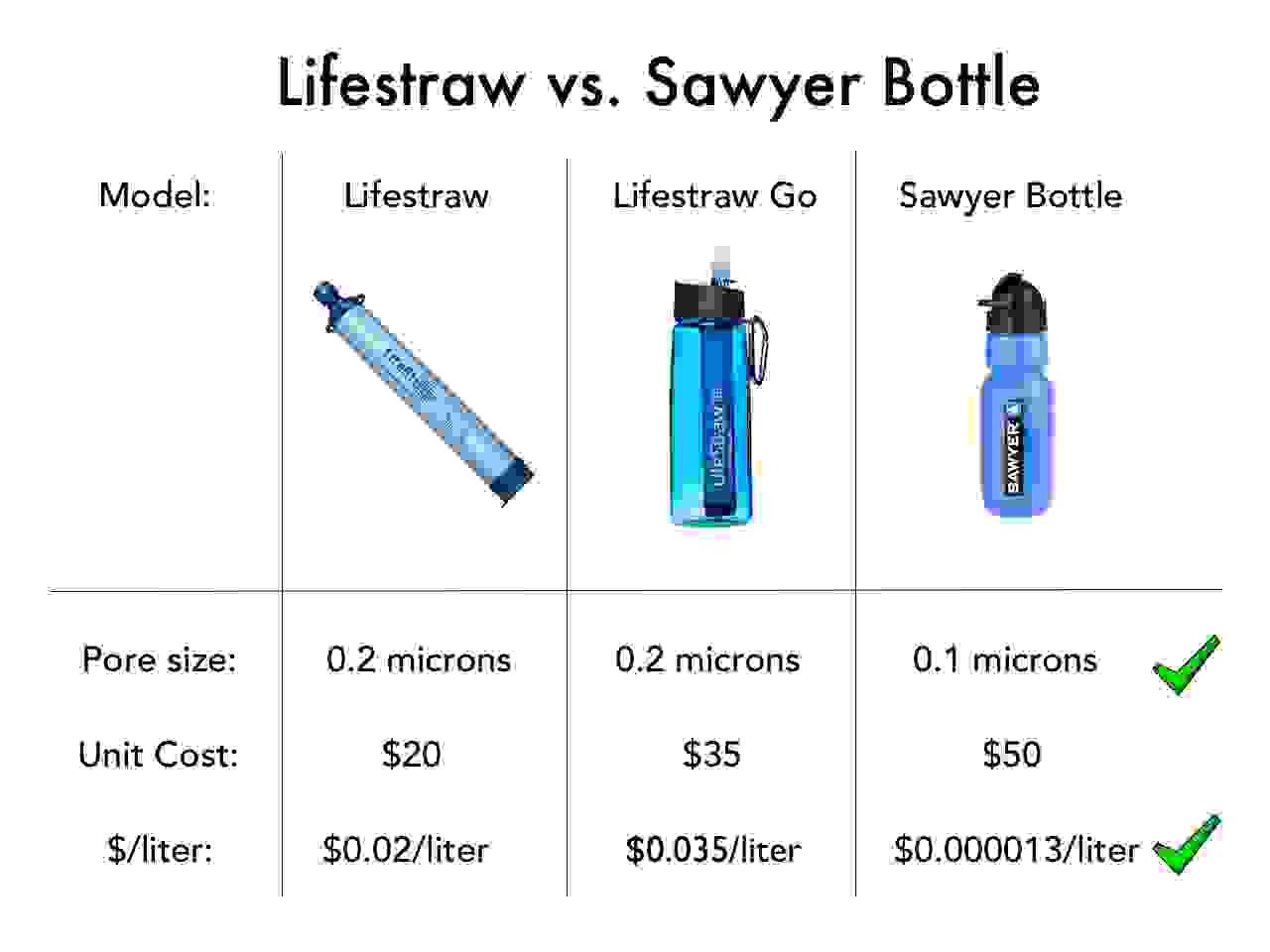
It has been claimed that the Lifestraw’s lifespan estimates are intended to be a little on the safe side, using low-quality water for all of its tests, which is good (and Sawyer’s lofty claims were put to the test, and were sadly shown to come up short, so the performance difference is likely to be smaller than what is claimed). And again, it’s not that it’s bad, and the filtration quality will probably work just fine if you’re hiking in North America, and you could supplement it with iodine tablets if you ever take it with you to Mexico, or wherever else you might want anti-viral protection. And if you’re drinking a liter of water per day, a $35 Lifestraw Go will last almost 3 years, which isn’t bad at all, and if you’re only using it for camping trips on weekends, it’ll last much longer. I also think it looks nicer than the Sawyer. So it’s definitely good; it’s just not necessarily the best, neither on filtration quality, nor on cost-effectiveness.
Update: After receiving and using the Lifestraw Go, I can say that it’s a pretty good product for hikers who plan on filling up from a river and just want a simple water bottle filter to do the job. Its filtration performance isn’t as strong as the Sawyer, nor is it as cost-effective, but it’s still effective and affordable, for non-viral filtration. Keep in mind it’s supposed to filter biological contaminants rather than chemical, meaning it’s more suited to filtering clear river water than tap water, which is more likely to have chemicals of some sort.
Two issues: Firstly, the Lifestraw Go does not use the regular Lifestraw as a replacement filter, but instead uses a slightly modified version. This means you cannot replace the filter inside the Lifestraw Go with a regular Lifestraw, and, at the moment anyway, you cannot buy just the replacement filter by itself. When your Lifestraw Go reaches the end of its life, you’ll have to buy an entirely new bottle. I expect that if the product is successful that they will offer those replacement filters by themselves, but it’s worth being aware of this issue.
Secondly, when the bottle is shut and the straw is folded down, it protrudes slightly beyond the edge of the lid, and it’s easy to get your grubby hands all over the straw when you pick up the bottle, potentially getting the straw a little dirty and thus defeating the purpose of drinking filtered water. This could be easily fixed, and I hope they do it. Second update: THEY DID!
If you think it’s for you, check it out here.
But again, neither of these devices will provide chemical or viral filtration. If you want to get rid of viruses, then you’ll need iodine tablets, or a UV light, or upgrade to a water bottle that actually gets rid of viruses, too.
What if I need serious purification?
For most people, high-quality filtration works just fine. If you’re hiking in North America or filtering tap water while traveling through modern countries, you probably don’t need virus removal to be safe. But if you’re traveling in developing countries with incredibly questionable tap water, you might want to take some extra precautions.
And yes, you can fit a whole purifier right inside a water bottle, like these do:
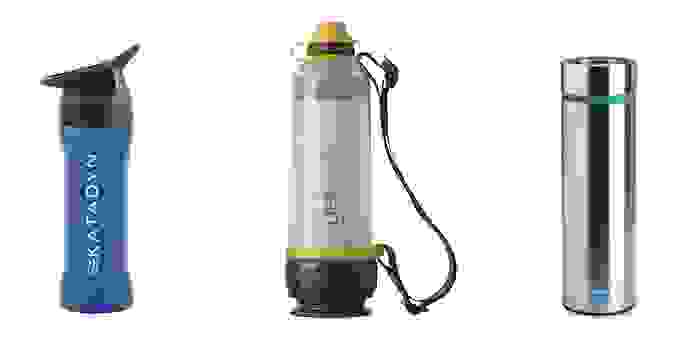
Each of these will clean out viruses, along with all the other contaminants, including chemical, that you’d want removed, providing thorough filtration beyond anything the Lifestraw can manage. Check out a thorough review of those three, including short and long term cost estimates, and suggested uses for each. They all work differently, without any objectively “best” option, so you’ll want to find a favorite that works for you. I’m currently using the GRAYL, which manages the nice trick of allowing multiple options for filtration quality as needed, and also looks nice and classy.
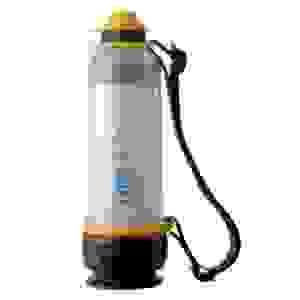
But I’d also like to highlight a close competitor to the Lifestraw, one which shares the design goal of providing high-quality, portable, durable water filtration to vulnerable populations in the third world, and which demonstrates what the Lifestraw could have been. It’s the Lifesaver Bottle, and it’s 13 times better.
The pores in the Lifestraw are 0.2 microns, whereas the pores in the Lifesaver are 0.015 microns, making them about 1/13th the size, which is small enough that viruses can’t get in. No more worrying about having to use iodine tablets.
It’s true that the Lifesaver is bigger, heavier, bulkier, and significantly more expensive (though long-term costs are actually quite good), whereas the Lifestraw was supposed to be so tiny and portable that you can take it with you wherever you go, which might actually mean it gets used more frequently by those who don’t want to bring along a bottle all the time. But…if you need a bottle anyway, and you want portable virus filtration, the Lifesaver wins.
Yet nobody seems to know it exists.
So why does everyone love the Lifestraw?!?!
Well, I don’t really know. It was even called the “Invention of the Century,” from a publication I otherwise enjoy, despite lower performance and higher long-term cost than competing options that have been on the market for years.
Again, it’s not bad, and the bottled version solves quite a bit of the silly ridiculousness of the straw-only version, but everyone adores the straw-only version, as a consumer product, which is absolutely inexplicable to me.
But I have a theory:
At $20, it’s cheaper than many other filters, and, admittedly, its filtration capability is pretty good, and a lot better than most of what I’ve seen for the same initial cost. It has a nice impulse-buy price point that gets people interested, and its unique design sets it apart in a world of filtered pitchers, faucet adapters, and so on. And when it arrives in the mail, people give it a try, drinking from a cloudy glass of water, and impressing some friends. Buyers are left happy.
And then they never use it.
Seriously. If you read the Lifestraw reviews on Amazon, you’ll see lots and lots of people talking about how great it is, who stuffed it into an emergency preparedness kit and never bothered with it again. They’re rating the product on how cool they think it is, not how practical it is in real-world use.
People actually love it so much that they videotape themselves drinking from jars of water full of feces…which is explicitly something the Lifestraw cannot handle, because water contaminated this way can easily have viruses inside, which the Lifestraw is incapable of removing. There’s a level of enthusiasm for this product that is literally dangerous.
So is the Lifestraw useful at all?
I would like to clarify that I am examining the Lifestraw from a consumer standpoint, rather than from a disaster-relief or third world disease alleviation product. It offers plenty of functionality in those situations, especially the Lifestraw Family, which is a larger (though still portable) filter intended for home use that does remove viruses. Most of my annoyance should be directed toward the overrating fanboys, who post videos of people drinking toilet water, and then resort to third-grade name-calling if anyone ever criticizes its performance or design.
So it’s certainly not horrible, particularly the bottled version, which is the only one you should bother looking at. Its filtration capability is actually quite good, and it’s pretty convenient. I just think it has been played up way too much in the media, and people salivate over it like it’s this work of art that no disaster-preparedness kit should ever be without.
Just remember that it is incapable of handling chemical and viral contamination, meaning you should only use it within a narrow band of circumstances; outdoor recreation, in North America (and similar settings), where the water you come across has neither chemicals nor viruses.
So it’s certainly worth a look, but I can’t say it’s the best. Competing products provide better filtration at a more cost-effective price, while other devices handle viruses as well, which is what you’d want in developing countries.
Check it out, but remember to…filter some of the adoration.




Just a note for Justine…there are forums for folks with Aspergers. Very soothing.
Snarky- Thanks for the info!
You are ridiculous and cold-hearted. Get over yourself. Justine purely expressed her opinion and called ‘SnarkyNomad’ out for his childish behavior – something you obviously share with him. This article is unfocused, pathetic, and uneducated. The ‘author’ seems to reflect these qualities. And don’t go throwing Aspergers into the mix. You don’t use something like that as a weapon on someone. Shame on you and your disgusting self. Shame on you.
I think they need to put graphene as a filter. Trough graphene only water molecules can pass trough, but this makes another problem, 100% water isn’t safe, because instead of delivering minerals like normal water, it will take the minerals so water and rest of the body have equal amounts. Drinking like 1 liter of distillated water per day is no big deal if you drink other things, but if only such water, it gets very unsafe.
Graphene seems to be magical.
A few months ago, I came across the LifeStraw, thought it was really neat, purchased it, and yes, have never actually used it. In fact, I took a few with me to Africa and gave it to my friends there for when they go into the bush. For the price and portability, I still think it is a good for emergencies but the viruses are a concern. Thanks to this review, when I go backpacking through South America in September I will be looking for something more and it will definitely include a bottle.
I found this post helpful and amusing. I caught myself giggling a few times so thank you for making it more entertaining than a regular boring review. I also read your post about travel backpacks and it was extremely helpful. I am considering the Minaal carry-on. I’m sure I will read more of your posts as I prepare for my trip so get used to me.
Always happy to have a fan. And nothing in the world brings me greater joy than to know my ranting is actually my most endearing trait.
This is one of the worst reviews for a product that I have ever read. This ‘critic’ (more like numbskull) dwells on the simplest ‘problems’ that could be ignored/overcome with zero to no effort. Who cares that you could have a wet straw after you drank the water. Who cares that wet clothes aren’t ‘sexy’. The straw is designed for its simplicity. And the people who buy it are practical people who don’t want to lug around a 1 lb plus filter or something. These people know that weight matter when hiking/trekking. These people don’t really care that wet clothes aren’t ‘sexy’- sweat isn’t either, princess. These people want something simple, that works – exactly what the LifeStraw provides.
I find it odd how someone might deride a discussion that raises an issue that would be a matter of life and death under certain circumstances (which people shopping for the Lifestraw may very well encounter), while simultaneously deriding the concept of convenience and efficiency by means of electricity, rather than Pony Express. But oh well.
I also take issue with the term “zero to no.” But oh well yet again.
You obviously don’t understand how to take any criticism whatsoever. If you are going to publish an article expect for some people to differ from your opinions. And next time, when answering someone, make sure that your statement holds some value or actually presents something worth stating.
Also, understand that this product isn’t designed for extracting viruses and such. It was originally designed to make cleaner water easier to access for those in at-risk areas. If you want to critique the product on how it has helped millions of lives, please make sure to come up with another idea that is this affordable that can help just as many people. Also, now that this product is being marketed to the general public, it is intended for those on hiking expeditions where viruses aren’t all that common – ie. North America, etc. – not beside biohazard waste sites or nuclear reactors. The product is meant to prevent E-Coli and Beaver Fever. Things that actual outdoor enthusiasts encounter – the average person that can’t reasonably spend $150+ on something they rarely use so that they can prevent things that they won’t encounter.
Hey Maurice you’re an idiot for having such a view on the matter!…. How would you like if someone called you this or similar then after your reaction which may not be the nicest or positive one you’re told ..”hey you don’t understand how to take any criticism”. That is in effect (or very close to) what you just did. It just goes to show what kind of a person YOU are! The guy was putting his view point across for those that know less or much less and may benefit from his information. Its not set in stone nor is it held as gospel or truth but ‘his’ truth. Therefore there is no need for name calling under the guise of ‘criticism’ by you or the likes of you (Justine etc). If the info is not for you .. fine, move on! or be mature enough to input kinder criticism not name calling etc. I personally (did I mention ‘personally’) had learned a lot from this guy’s comments and I thank him for it. Either way I understand it is HIS truth.
Do you work at Lifestraw?
The problems the author mentions are helpful to those of us with less experience. Sure, while what he says might not apply to some people, it’ll apply to others.
And from what I’ve experienced, the less things that you have to worry about the better your trip will be.
“pretentious English major ” is an understatement here…
This a great, affordable product for outdoor enthusiasts, it does an effective job for the North American backpacker. It’s light weight is a strong feature. Having to open a water bottle, insert the straw, drink, and then close the bottle is NOT a major design flaw, it’s called nit picking. I will gladly spend an extra 15 seconds every time I want a drink to save 10 oz in my pack.
I think your review brings up some good points but mainly focuses on some minor faults with it and I get the impression you initially wrote the review without even using it.
I am an avid user of the straw having used it in three continents and I have had no problems, however your review did highlight some alternatives to which I had overlooked.
Firstly the straw is explained on the packaging to be used in a bottle, as you mentioned. So why rant on the use of not having a bottle? Is it that bad that you need an empty bottle large enough to fill with water and then put the straw inside? Personally I prefer just having the straw and then the option of what size bottle I want, but that’s just me. This method then allows the option to not carry any water if you know your near a water source. On a days hike this can save you carrying 2 litres/5 pounds of water.
Another point to be made on your practicality part is in using the straw with a bottle. You make the unclipping of the caps seem like a mission when it takes a second and if you put them back on, you don’t get a wet shirt. At least I don’t.
Secondly the virus point is valid but I personally think it is made far too big an argument in your review. I’m not 100% sure on all the stats but I think to be seriously ill from a contamination of virus, you need to drink a source rife with the pathogen. I’ve used the straw on stagnant amazon river water in Peru and Brazil and was fine.
Finally despite your comparison with other competitors being 100% factual they are almost meaningless. Yes reducing the filtration by a micron with the sawyer bottle is reducing the contamination by half but at the end of the day it’s a micron. This is almost negligible.
But the biggest misunderstanding is with the quantity of use. Saying the life straw only lasts 3 years makes you sound like a poor REI salesman trying to convince the sale of the more expensive product. Filtering 3.7 million litres is just over engineering! A person would struggle to drink 100,000 litres in a lifetime, let alone 3.7 million!
And yes technically the lifestraw would only last three years, but that’s if you drank nothing but filtered water through the straw solid for three years. I don’t know about you but even if I was left on a desert island with nothing but the straw I may drink the odd coconut.
In practical sense 1000 litres is more than enough for a lifetime of hiking if like me you like to have the odd cold can of coke or beer in between your adventures.
As said though, your review pointed out some interesting alternatives but be practical on your review. Most people who use it will be practical people who won’t drink 3.7 million litres of water or be so stupid to lie on the ground, attempting to drink a puddle of diarrhoea filled with viruses.
I can definitely see these points, and living with the limitations of the Lifestraw certainly isn’t impossible, particularly for hikers who only need non-viral filtration on the weekends, and thus won’t run through the lifespan of the device. This is the target market for the consumer production of the Lifestraw, because it suits them fairly well.
But I think the bottled version is like a smartphone. It doesn’t seem like a big deal to those who don’t have one, but once you upgrade, you’ll wonder how you ever did without it. I’d be willing to bet you a beer that if you go hiking with one each of the straw version and bottled version, sooner or later you’ll be reaching for the bottle every time.
And…lastly…there ARE people who drink from a puddle of diarrhea filled with viruses…on video…simply to prove the Lifestraw can do it. This is why I find the attention paid to this device to be so dangerous. The fervor behind the Lifestraw is so strong that people will literally perform video demonstrations sucking water out of a jar of wet manure to prove its effectiveness. That’s how good they think it is. They might get lucky with a virus-free jar, but they’re playing viral Russian roulette with a jar of disease.
It’s not that I think it’s bad; it’s that I think it has been unjustly idolized. But if people understand its strengths and weaknesses appropriately, it can be used quite effectively.
On my first reading of your ‘review’, I was inclined to think that you perhaps worked for one of the alternative filtering device manufacturers as you seem to be inordinately superficial with your comments about LifeStraw’s seemingly minor inadeqacies….but the more I read your responses to others’ comments, I no longer think that is the case. Now i am almost totally convinced.
Your preoccupation with having to uncap the straw and bottle and having to recap them again is woefully trite and nitpicking to the nth degree…as is your comment about the ‘fervor’ for the Lifestraw.
Did you ever stop and think that the ‘fervor’ was generated by clever marketing agents to get their product noticed, to which – if your reaction is any guide – has worked magnificently!
Your woeful and abysmal attempt at a ‘review’ is so totally biased that it nullifies any legitimate concerns you attempted to convey to your readers.
Face up to the fact that product reviewing is not your forte….nor should you ever try to convince yourself that it is….or ever will be.
As you yourself said…. “Ugh, people are dumb!” ….and the sooner you accept that you are one of those “people”, the sooner you can stop acting like an anal-ferret and find something more suitable for your limited abilities.
Cheers.
It’s hard for me to imagine the inability to filter viruses as a “minor inadequacy,” since viruses will literally kill people. It’s weird. People talk about how great this is, but if you point out a potential shortcoming, all of a sudden they attack the view with…like I said…fervor.
No ‘fervor’ in my ‘attack’ lad. Just pointing out the obvious. And the main contention that you initially started with – which you seem to have forgotten – was your premise of someone having to lay down to have a sip of water. Perhaps you need to reread what your opening main contention was… “The massive, glaring problem no Lifestraw review ever seems to mention”… which was having to lay prostrate to rehydrate ones self. Your “seriously, look at the snazzy in-action shot of a guy using the Lifestraw out in the real world” speaks volumes to your pathetic attempts to over sensationalize insignificant shortcomings of the product.
Had you suggested changes to the design of the product without all the attacks against it and references to better products available, you might have had more creedence with the readers.
One last thing to consider….every time someone posts a comment disagreeing with your assessment of the product, you feel it necessary to try and justify your original assessment and try to convince everyone that you are right and that no one else should have an opinion that differs with yours.
THAT is the sign of someone who really has control issues and obviously suffers from S.P.S. (Small Penis Syndrome) ….but then, didn’t we all already know that!?!
I already know that when I check back again there will be another comment awaiting me as you are incapable of taking criticism – yet another symptom of someone suffering severe S.P.S.
Cheers maggot.
People are so good to one another. I love the internet.
I’m leaving their comments up because they don’t even seem to realize they’re proving my point. There’s better stuff out there, but people get angry if you even suggest it.
Don’t worry about em snarky. Logic and common sense can’t be used while in debate with fucktards!!!
Justine Maurice and the other haters please feel free to suck up some sewerage with your life straws and let natural selection do its thing!
DITTO Tony. Snarky, I found the review informative, helpful and well written. From one word smith to another, thanks and well done. Ignore all the whining by those with nothing better to do with their time, because responding to them is pretty much a useless effort. Obviously they know more than you do and are able to reason better too.??
He is “leaving our comments up” because he would look like a pedantic little ass weasel if he did otherwise.
And although he would like to have you believe we are ‘angry’, the truth is we are just trying to educate the little snot-gobbler. He seems to have convinced himself that he is the only person with a relevant opinion and his opinion MUST be correct as HE WROTE IT.
It is a very sad day – a very sad day indeed when a condescending little perineum-breathed anus eating colon escapee tries to control others’ opinions with headlines screaming “THE ONE PROBLEM NO LIFESTRAW REVIEW EVER MENTIONS” – which turns out to be laying down to get a drink of water in a survival situation. Oh my God….the inhumanity!!!
Now, now Jonathon. You are not setting a good example of the proper role model for your son, Clark.
The Lifestraw would be of immense benefit to many people in Africa, especially among the very poor, if it could be made affordable. At their current prices – $20 and $35, respectively – only the rich can afford it. If the makers could produce something that fits into a .5 liter bottle of water, they will really go far in saving many Africans from water-borne diseases.
I would be interested in working with them to enlist distributorship
Yeah, that’s part of the problem…but I don’t blame Lifestraw for that, since they’re basically forced to develop high-tech gadgets in developed countries, then somehow get the price down low enough for developing countries…that’s tough. Any sort of global filtration infrastructure would have to be done through charitable actions by the wealthier nations, but of course I see no problem supporting a plan like that.
I am trail runner and keep Lifestraw in my backpack. I sometimes use it once I run out of water on a trail in areas with many streams and it works really perfect. Hence, I take just 1.2l of water on 30km trails and can always find some stream if I need. The Lifestraw Go would not be very practical in my case, because it takes too much space and I don’t need to carry much water. I would probably consider Lifestraw Go on terrain with very few streams. I agree that drinking directly from a stream is not too comfortable, so I actually created a mod with a 30m transparent pipe, which works really well and I can also use it to pump the water back to bottles.
I agree that trail running is a good use for the Lifestraw. You don’t need to carry anything around, so its smaller size is actually a good thing, and if you’re near a river or a lake, you don’t need to carry a bottle.